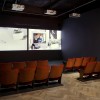At the 1968 inaugural exhibition for Boyle’s World Series, visitors were blindfolded and asked to throw darts into a large map of the world. It is from this chance arrangement of pinholes on the planet that the Boyle Family selected its sites, for a body of work now spanning more than forty years, which they call contemporary archaeology. Using paint, resin and natural materials from the site, the Boyle Family recreates a portion of rippled beach; a street kerb, or a section of rock face. Excavations, measuring between three and fifteen square feet, are set in frames and hung on the wall. Just as an archaeologist examines unearthed artefacts with a meticulous and impartial eye, the Boyle Family documents detail without comment on its value or significance.
In this exhibition, the archaeological World Series continued with a collection comprising three pieces and a number of photographs from a site in Lazio, a district in Italy. The original map occupies one wall. The colours are muted, and there are small tears in the folds. The white border is spotted with sepia tones of aging. A serif font in which country names are printed dates the map to a period when ornate scripts were fashionable. Circles are drawn in pencil around tiny holes in the map, and a few have ticks against them.
In one image there is coarse sand, shingle, and a charred portion of the beach where a fire has been built, reproduced with forensic accuracy. A burnt twig is partially embedded in the shore. A pebble balances on smaller stones, and mauve coloured grit mixes with softer, dirty yellow sand. Two three-dimensional exhibits appear to be of a portion of chalk cliff face, approximately 3’ x 3 ‘and 18” deep, the bleached white contours of rock worn by wind and water.
Also exhibited are a number of enlarged photographic images of plant and animal life. These are magnified pictorial studies of vegetable, mineral or animal matter; previously, single strands of body hair have been enlarged to produce photographs of towering proportions. Here, magnified examinations of organic material produce repetitious hexagonal shapes, images of what appear to be swollen buds, and photographs of voluptuous petal-like structures. What is striking is the order and symmetry in these pictures; the staggering molecular beauty.
A melted slide from Projections 1966, printed 2013 by the Boyle Family, is in the Art Under Attack, Histories of British Iconoclasm exhibition at Tate Britain until 5 January 2014
Other work can be seen in Ends of the Earth, Haus der Kunst in Munich until 20th January 2013
Go to the Boyle Family for further news on forthcoming exhibitions.











